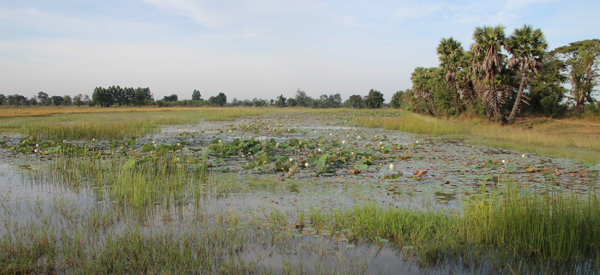
Rice paddies and small wetlands among the paddies, along with large wetlands associated with reservoirs, will perhaps provide excellent nesting habitat as the released Eastern Sarus Cranes reach sexual maturity at the ages of 3-5 years. Thai colleagues are considering how to best compensate farmers for crop damage is such happens.
By Dr. George Archibald, ICF Co-founder & Senior Conservationist
Mid-morning, November 25, Thai colleagues and I are observing a pair of yearling Eastern Sarus Cranes digging and swallowing large sedge tubers from a harvested rice paddy near the Jorakae Non-hunting Area. To farmers, the sedges are weeds and thus killed by herbicides. So perhaps the cranes are, in a small way, helping the farmers.
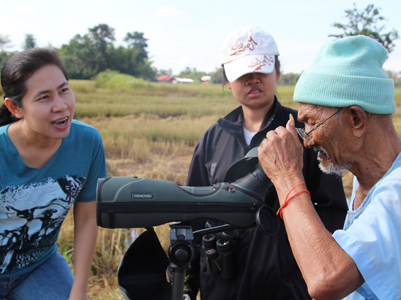
Suddenly an elderly man appeared riding a bicycle along the dirt road. His name was Mr. Nhu Pogang, and he has been a resident of this area for all of his 83 years. In his youth, the region was mostly forested with open wetlands in low-lying areas and cranes were common. He recalled they constructed large platform nests in the shallow water. The subsistence farmers never harmed the cranes, but their eggs were a delicacy! After the Second World War traditional agriculture conceded to industrialized agriculture. The forests were harvested, the wetlands drained, and large acreages of monocultures – rice, sugar cane, and such were established. Soon the cranes disappeared. Through my telescope, Mr. Pogang was thrilled to see them again.
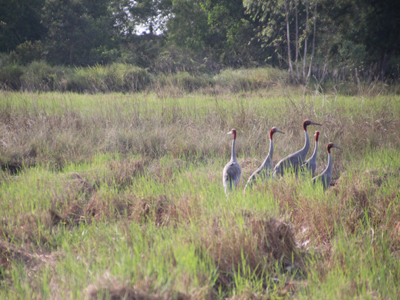
Eastern Sarus still survive in the wild west of Thailand, in Myanmar, and east of Thailand in Cambodia and Vietnam. Little is known about the cranes in Myanmar, but their population is estimated to be in the low hundreds. However, studies of the cranes in Cambodia and Vietnam estimate the population is at a minimum of 800 cranes. The major breeding area of the cranes east of Thailand is the forested area of northern Cambodia, where as in former times in Thailand, small scattered wetlands provide nesting habitat. If Cambodia follows the path of Thailand in converting forested lands to industrialized agriculture, the cranes might also vanish there.
Modifying the models developed in the USA, where captive-reared cranes are released into the wild to maintain a wild population of Mississippi Sandhill Cranes and to attempt to establish new wild populations of Whooping Cranes, since 2011, Thai colleagues have been engaged in an ambitious program to bring back the Eastern Sarus to landscapes of Thailand.
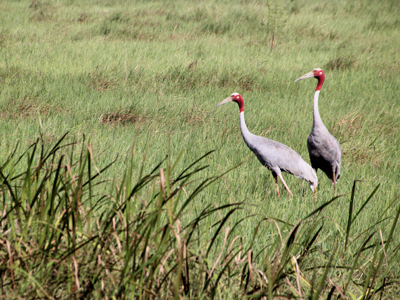
Extensive research by colleagues at Mahidol and Mahasarakam Universities to determine the most suitable areas for releases concluded that two reservoirs and associated non-hunting areas, Jorakae and Sanambin in Buriram Province that borders northern Cambodia, as the sites with greatest potential for cranes. A rigorous and most successful captive breeding program at Korat Zoo under the dedicated and gifted direction of Mr. Wanchai Sawasu has provided 46 birds for release since 2011. All of these activities have been sponsored by a large grant from the Government of Thailand to the Zoological Park Organization (ZPO). Researchers at the Bureau of Conservation, Research and Education (CREC), Dr. Sumat Kamolnorranath and Dr. Boripat Siriaroonrat have administered the project, while Mrs. Nuchjaree Purchkoon at CREC and her team of researchers, have directed field research associated with the reintroduction. Every November since 2010, I have spent a few days with Thai colleagues to help with next steps.
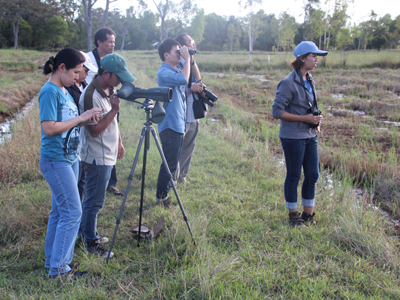
The first release in 2011 included 10 birds at the Jorakae Non-hunting area. One died from an infection, two were killed by people, six either died or flew away to unknown locations, and only one is known to have survived to present. Unfortunately, radio transmitters were not attached to the cranes, making it almost impossible to locate the cranes if they went far from the release area.
The second release in 2012 included 15 cranes releases at the Sanambin Non-hunting Area. Radio-transmitters were attached to 15 birds. One crane died from pesticide poisoning, another was shot and brought back to Korat zoo, and 13 have survived to date.
Releases were upgraded in 2013 to include 21 birds including the release of three adults that had been reared by their parents in captivity. Parent-reared birds are usually afraid of humans. These cranes were released in March (11 birds) and in August (10 birds) and to date their survival has been excellent.
Although the cranes range as many as 60 km from the release sites, they usually return after 30 – 90 days. On November 25 we were thrilled to able to observe a total of 20 birds in the wild in and near the two release sites, which that are separated by only 30 km.
My congratulations are extended to the Thai Crane Team. They are doing excellent work. It is a thrill to hear and see the world’s tallest bird that flies on the landscapes of beautiful Thailand.
